26. BUSH (II) FUMBLES THE BALL

THE BUSH ECONOMY
CONTENTS
 The growing national debt crisis and The growing national debt crisis and
American trade imbalance
 The growing income inequality in The growing income inequality in
America
 The September 2008 financial meltdown The September 2008 financial meltdown
 TARP: Bush
moves to bail out the TARP: Bush
moves to bail out the
troubled firms (October 2008)
The textual material on this webpage is drawn directly from my work
America – The Covenant Nation © 2021, Volume Two, pages 375-386.
THE GROWING NATIONAL DEBT AND INTERNATIONAL TRADE IMBALANCE |
|
The growth of the American national debt.
During the Bush Presidency the American economy
seemed to stall. The American economy was fairly strong, but not
growing, certainly not at the rate that it had been used to over the
years since the end of World War Two. And it seemed that the primary
way that the economy, and Americans themselves, could maintain the
nation's prosperity was by going into debt, not a good thing over the
long term. Americans sensed the dangers, but were not quite sure what
to do about the situation.
By the beginning of the last full year of
the Bush presidency (2008) the debt of the U.S. government had climbed
to around ten trillion dollars, more than double what it had been when
he took office at the beginning of 2001. This figure meant that every
American citizen, man, woman and child, each shared about $30 thousand
of their government's debt or about $60 thousand for each tax-paying
worker.
During those seven years the national
economy registered dollar growth, but not nearly as fast a rate as the
public debt. In 2001 the public debt stood in size at about 57 percent
of the figure for the national economy or Gross Domestic Product (GDP).
By the beginning of 2008 that figure had grown to 70 percent.
The U.S. Treasury Department could not simply print money to cover that
debt. Instead it had to sell its debt as "securities" to investors who
were willing to buy these securities, with the promise that the owners'
investments would be paid back in the future along with accumulated
interest earnings. Americans themselves bought some of that debt in the
form of government bonds (EE bonds being the favorite). Retirement
programs and insurance companies bought some of the debt as a low risk
(but also low paying) investment. Interestingly nearly half of that
debt was bought by the government itself, in particular the nation's
Social Security program (which at this point held about two trillion
dollars of the debt) and other U.S. government trust funds.
Slightly more than another quarter of the
U.S. public debt was held by foreigners, either governments or banks,
as part of their hard currency reserves (the U.S. dollar gradually
replaced gold as the international monetary standard, and at that point
was still constituting about 60 percent of the world's hard-currency
reserves). The two biggest holders of dollars were by far China and
Japan with each of them possessing about 20 percent of these foreign
holdings.
There are several reasons for anyone
wanting to purchase U.S. government securities. But one of these
reasons certainly is the interest payments that the government had to
make to the owners of these securities. This could however get to be a
very expensive part of the government's operating budget, as in the
past when the Federal Reserve forced American interest rates up to
about 20 percent. Such a high interest rate would mean that the
government could have been paying $200 million a year on each $1
billion in debt, something the government simply could not have
sustained.
Actually, toward the end of the Bush
presidency the Federal Reserve was holding that interest rate to under
1 percent! This made the size of the government's interest payments on
the debt quite manageable. But such low rates were most exceptional
historically. If people and countries were to lose confidence in the
American economy, they could certainly have demanded higher interest
payments before they would be willing to continue to buy these
securities. Having to raise interest rates on these securities would
have been a blow to the government budget, which would have had to
raise taxes, cut back on programs or raise more debt, or a bit of all
three of these measures. This would have put a great strain on the
economy and set off a round of fears about the economy that could have
escalated into even greater problems in selling the national debt.
The huge American trade imbalance
While there was no question about how bad
the American national debt was, the question of the huge imbalance in
American trade was much more debatable: was it a bad thing or a good
thing? Americans were importing more goods than they were exporting.
This produced what is called a deficit in the balance of trade. Since
1997 this deficit had grown monumentally. By the last years of the Bush
presidency the size of the trade deficit was about $700 billion
annually.
The biggest source of the imbalance in
trade was China. America was importing more than four times the value
in goods that it exported to China. This trade deficit with China made
up about a third of the total American trade deficit. As a result of
this, China had been accumulating huge dollar holdings, some of which
it used to purchase U.S. debt, and some of which was used to buy up
assets around the world, such as oil, minerals, corporations, etc.
Originally (back in the 1980s and 1990s)
America had been willing to open up its markets to Chinese goods as a
means of helping China convert from a Communist (Socialist) economy to
a free-market or capitalist economy. At the same time, the Chinese
markets were allowed to be protected against sophisticated American
goods, in order to help China develop its own free-market industries.
And the Chinese currency, the renminbi or yuan, was allowed to be held
artificially low to help keep the prices of Chinese goods low so that
they could be more competitive in the international (and particularly
the American) market.
But those years of infancy in the Chinese
industry at this point were gone. China had the second largest national
economy in the world, and was continuing to grow rapidly around 8
percent to 10 percent a year. But the protections remained in place,
despite American complaints that it was time to let the renminbi float
to a natural market level and to end China's restrictions against the
importation of foreign goods. But America had to tread warily, because
it needed China to buy continuing (growing) American debt. The loss of
the Chinese investor in the American debt would spell serious trouble
for the American government. In a sense, America now found itself in a
financial trap of its own making – with no good means by which to get
out of this situation. This was indeed very bad for America – and
possibly for the world, at least the world that America was trying to
support.
But China was not the only country
benefiting from an American trade imbalance. Nearly every one of
America's major trade partners enjoyed a large surplus in trade (and
thus a strengthening of their dollar holdings) due to the fact that
Americans purchased more than they sold abroad. The argument was often
put forward that this was actually a very good thing for the world
economy. The American consumer market was the engine that ran the
world's economy. It was important not only to China, but also to Japan,
Mexico, Korea, Germany, Britain, and in fact the European Union in
general, where American purchases of their goods added greatly to the
profitability of their companies. Only Canada, America's largest trade
partner, traded at anything like parity with America (but Canada too ran
a small 5 percent surplus in its trade with America).
|
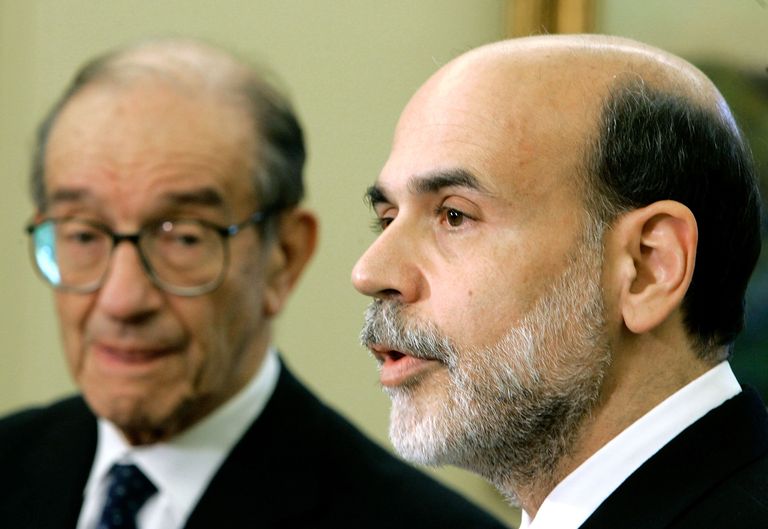
Former long-time Federal Reserve
chairman Alan Greenspan
... and replacement nominee, Ben Bernanke
(2005)
GROWING INCOME INEQUALITY IN AMERICA ... AND
THE CULTURE OF GREED |
The growing income inequality in America
A study put out by the Center on Budget
and Policy Priorities (January 23, 2007), based on figures released by
the Congressional Budget Office, showed how American after-tax incomes
had changed over the period 1979 to 2004. The lowest fifth of income
earners had advanced only by 6 percent during that 25-year period. The
next highest fifth had advanced by 17 percent, the middle fifth by 21
percent, and the next highest fifth by 29 percent. But the incomes of
the highest fifth group had advanced during that time by 69 percent;
and of that last group the top 1 percent of income earners had advanced
by 176 percent. The gap between the richest and poorest Americans was
widening rapidly. This was an economic profile looking very much like
the massive inequality that developed in the late 1800s – the "Gilded
Age" of the industrial "robber barons" (America's super-rich families)!
A similar study published in The New York Times
(March 29, 2007) pointed out that during the one year alone of 2005 the
national income figure increased by almost 9 percent. That sounds like
great growth for the country. However, the study pointed out that
nearly all that growth occurred with the top 10 percent of income
earners; the lower 90 percent actually showed a slight dip in incomes
of 0.6 percent. And of the top 10 percent, it was the top 1 percent
that registered the largest growth, namely 14 percent. Indeed, the top
0.1 percent of the population (some 300,000 individuals) had almost the
same total income as the bottom 50 percent or 150 million Americans.
Their incomes were 440 times the average income of the lower half of
the economic scale, almost twice the disparity that it was in 1980.
There were all kinds of explanations for
this growing gap. The loss in the late 1970s and early 1980s of
decent-paying blue-collar industrial jobs overseas to countries that
pay their workers less was certainly one of the factors. Another was
that as America turned away from manufacturing to service industries in
the areas of banking, insurance, medicine, law, high tech
communications, etc. more education was required of America's workers.
The high-school diploma was no longer adequate, and thus more expensive
post-secondary and even post-collegiate graduate study was required,
necessitating the increase in salaries of those employed in these
service industries in order to cover the schooling expenses they had
incurred. Also the figures were skewed downward by the huge influx of
foreign workers (documented and undocumented) who filled the very
low-paying manual-labor jobs unwanted by Americans. Certainly these
factors contributed to the income gaps between the richest and poorest
in America.
But the gaps were widening at a pace
faster than could be explained by simply the shift in American industry
from manufacture to the service industries. The statistics for the
shift in the one year alone, 2005, demonstrated the size of the
problem. Incomes went up at that rate because some people simply
expected their incomes to go up at that rate. Other Americans were
forced to be content merely with holding their own.
For example, in the field of medicine
each year the size of the average medical insurance premium jumped
anywhere from 6 to 10 or 12 percent. In no way could anyone say that
the medical industry had improved that much over the previous year,
that it therefore justified an annual increase in payments of that
size. Everyone in the medical industry pointed to others in the medical
industry. Hospitals got the biggest blame, right along with trial
lawyers specializing in medical malpractice suits. But people who sued
doctors (encouraged by the trial lawyers) were to blame. So were the
doctors who in the past made sure that there was a scarcity of medical
schools training new doctors. Thus many American medical students went
abroad for their studies, and many practices had recently been taken up
by English speaking immigrants from Pakistan or India in order to fill
the gap.
Or the field of higher education as
another example. Here too expenses (tuition, room, board and books) had
been climbing much faster than the national inflation rate. For middle
and lower-income families this made a higher education almost beyond
reach. Scholarships were available, though these were pegged to the
performance of the economy, which had not been growing much over the
past decade or so. Where did this tuition money go? More classrooms and
teachers? Not usually. America had not only the fanciest hospitals in
the world, it had the fanciest college stadiums, research laboratories,
libraries, student centers and administrative buildings (and
administrative salaries) in the world.
Corporate salaries of company CEOs were
another example of the kind of social differentiation that was going
on, one that set some Americans way above others in social rewards,
prestige, and the ability to demand even more. The explanation was that
if companies did not offer such salaries to their executives, they
would lose out in the salary-bidding game to their competitors. And
this game got more competitive over time. That is why the top salaries
were growing at such a stupendous rate (that included also the salaries
of hospital administrators and university presidents as well as
industrial and commercial presidents).
Indebtedness and "entitlements" as a way of American life
Another reason that the upper income
earners were able to get away with the large annual increases in their
incomes was because the average American believed that people should be
able to have as much as they felt entitled to. There was, so far,
little grudging of the huge incomes of the top earners by those who
were making far less. "Get what you can out of life" was almost a
national mantra (especially with the rise of the Boomers).
In line with this same mentality was the
fact that despite the slow growth in the income level of most
Americans, nothing had stopped them from accumulating the material
blessings that would have come their way had their incomes actually
increased. They simply purchased what they wanted on credit, with the
vague idea that eventually they would pay down their debts – someday.
Credit card companies had been willing to extend credit limits
fantastically beyond what people were realistically able to carry –
even though this would produce a high likelihood of eventual default or
bankruptcy on the part of their customers. Like the stock market craze
of the latter half of the 1920s, greedy expectations had blinded
Americans to the need to bring this destructive thinking under some
kind of discipline.
But then the huge run-up of the national
debt seemed to fit well with this same mentality. The government had
been able to accumulate this massive, virtually unrepayable, national
debt – without alarming the country too much, because indebtedness set
off no alarms to a huge number of Americans any more. Massive
indebtedness had simply become part of the American way of life.

Wikipedia – Financial crisis of
2007-2008
THE 2008 FINANCIAL MELTDOWN |
|
The subprime mortgage crisis
This economic mentality was very much a part of
the housing boom and house-pricing bubble that started to climb in the
mid-1990s, and by around 2005-2006 had hit a very dangerous peak (note
however that this was not just an American phenomenon during this
period but almost universal in the industrial world). People were
watching the prices of houses climb rapidly during this time (the
average price of an American home doubled during that ten-year period),
to a point where two thoughts worked together to get people into the
housing market – and way over their heads in mortgage debt. Firstly,
for first-time buyers, they had a feeling that if they waited, the
prices of their dream houses would get even further beyond their reach.
Secondly, they speculated (as people do typically in times of a growing
bubble) that if they found themselves overstretched with mortgage
payments, they could always sell their houses later at a much higher
price, and even come away with a nice profit in the process. But as
with all such bubblesque or speculative thinking, that was presuming
that prices would continue to climb skyward continuously.
Also most of these buyers financed these
expensive homes with adjustable-interest mortgages (ARMs), which
initially were always a bit lower than fixed-interest mortgage rates.
But of course adjustable interest-rates could do just that, adjust over
time, normally in an upward direction. All of these factors were a
recipe for financial disaster.
Banks were aware that people were buying
houses they could not afford, but they continued to extend to them
anyway subprime mortgages ("subprime" because they were highly risky in
terms of the borrower's real financial ability to meet future
payments), throwing caution to the wind. Banks were competing in the
numbers game to see which of them had the largest dollar amount of
assets.1
The awaiting disaster finally hit in 2007
when housing construction finally began to outpace housing sales,
leading contractors to have to start lowering house prices in order to
clear their inventory of completed but empty houses. Therefore, people
needing to move were finding that they too had to lower the prices on
their houses in order to make a sale. Soon the competition to find
buyers heated up and housing prices began to drop dramatically. Banks
began to get nervous and rescheduled adjustable-rate loans at higher
interest rates. Many subprime borrowers found that they could not keep
up the payments at these higher rates, and lost their houses to the
lending banks. But the banks really did not want the houses, they
wanted the mortgage payments. Now the banks had to turn around and sell
the houses – often for less than the banks themselves had invested in
them in terms of the original mortgages. Thus the banks began to fall
into trouble right along with the failed homeowners. The housing bubble
was bursting.
Americans expected banks and financial
experts to be well-informed and wise about investing in highly risky
ventures such as the subprime mortgage market. After all, housing and
commercial property bubbles occurred all the time. And disasters
accompanied these bubbles all the time. But banks, major banks, seemed
unwilling to move into the housing market cautiously during the
1995-2005 skyrocketing of housing prices. The fear in the short-term of
missing out on the opportunity to gain huge profits from these risky
investments outweighed the fear of being left, in the long term,
holding worthless assets should the heady speculation cease. And thus
banks jumped greedily into the waiting catastrophe.
1A
mortgage owed by a family to a bank is considered a bank's asset,
because mortgage interest is a vital way that banks earn money. And,
after all, the house is also legally the bank's until the mortgage is
fully paid off.
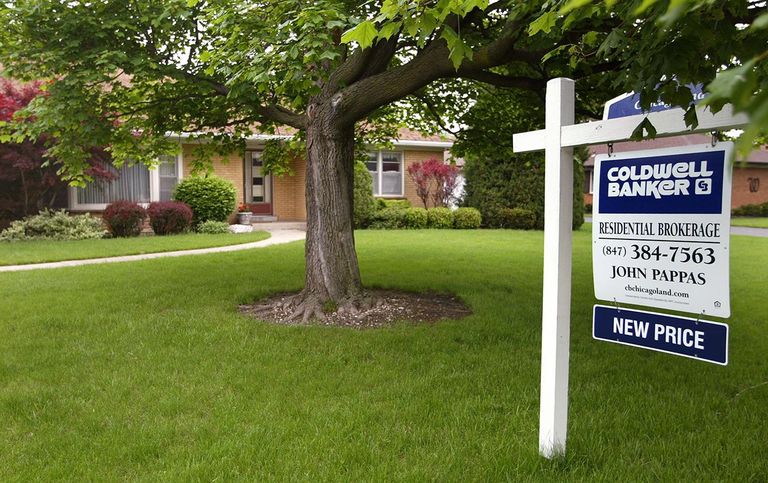
2006 – Housing prices begin to drop for
the first time in eleven years 
People are now hard pressed to find buyers for the houses they
cannot continue to afford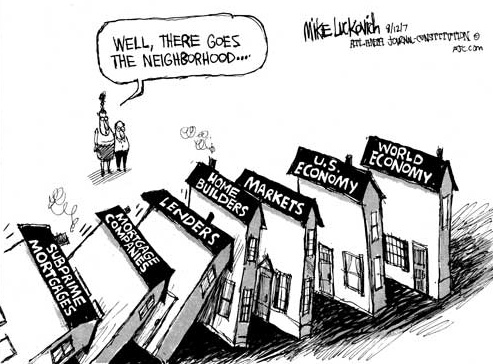
|
The September 2008 financial meltdown
Two of the biggest banks in the mortgage market
(holding about half of the mortgages on American homes) were actually
set up by the federal government to aid homeowners in securing
mortgages. The Federal National Mortgage Association (Fannie Mae) was
created by President Roosevelt as part of his New Deal during the Great
Depression of the 1930s. The Federal Home Loan Mortgage Corporation
(Freddie Mac) was established in 1970 to facilitate the buying and
selling of mortgages on the secondary market, freeing up money for
banks to be able to make mortgages more readily available to home
purchasers. Contrary to what is commonly believed, these are not
government-owned corporations; they are not (or were not) even
government-backed corporations. They are Government-Sponsored
Enterprises (GSEs) only. Ownership belongs to private investors, just
as with any other corporation. However, many people (including foreign
investors) invested in these corporations believing that they had the
full backing of the U.S. Treasury. As many would soon discover, this
was not the case, at least not originally.
Both GSEs had ventured deeply into the
subprime, Adjustable Rate Mortgage (ARM) market to keep their earnings
at the level they had been enjoying when the housing market first
heated up in the late 1990s. This all looked very good on paper. But
the fact is that by 2005-2006 both organizations found themselves
hugely overextended. By mid-2007 both of these huge mortgage companies
were in serious trouble.
By late 2007 there were clear signs that
the economy was slowing. The White House decided that what the economy
needed was some economic "stimulus" in the form of new tax breaks for
businesses and large tax rebates for American families (the Economic
Stimulus Act of 2008). In late January and early February Congress
authorized approximately $150 billion in such tax rebates. By late
spring of 2008 the benefits were out, and the economy picked up
(somewhat). But beneath it all was a waiting catastrophe.
The first signs of the looming
catastrophe came with the news that the huge investment bank, Bear
Stearns, was in deep trouble. It was terribly overextended in the
mortgage market, leveraged with debt it had accumulated to invest in
the wildly speculative housing market (it had borrowed about 30 times
as much as it had in real capital). White House economists scrambled to
find a buyer for the company. JP Morgan agreed to the deal, as long as
the government would lend $30 billion to cover the unwanted mortgages
portion of the deal. The company was saved, and a panic on Wall Street
was avoided, for a few months.
Meanwhile, attempts had been made in
previous years by the White House to reign in the speculation of the
two GSEs, Fannie Mae and Freddie Mac; but Democrats resisted these
efforts, defending these organizations as the hope of the little man.
But by mid-2008 the catastrophe hanging over both organizations was
obvious to all. Panic had set in among the mortgage speculators and
both GSEs were facing total collapse. In July, both organizations were
put under tight regulation, and the Federal Reserve was authorized to
step in to offer low interest rate loans to both organizations in an
attempt to restore confidence in them. But the crisis was too big. By
August of 2008 both organizations had lost 90 percent of their stock
values (as compared to their value the previous year). In early
September the government (the U.S. Treasury) had to step in to bail out
both institutions, to the tune of $100 billion of taxpayers' dollars
committed to each of these two institutions in order to get them back
on their feet. These were now in large part (temporarily, it was hoped)
government-owned. The bail-out saved the organizations, but seemed to
have little effect in stopping the panic. Investors were now scared
that other corporations that were over-leveraged in the subprime
mortgage markets were also facing failure.
By the weekend of September 13-14, the
panic was spreading as a major meltdown of the world of investment
banking. The panic hit the huge Lehman Brothers investment bank,
enormously overextended in the wild investment game. It was so
leveraged with its paper assets that it took only a 3 to 4 percent
decline in the value of those assets to collapse this prestigious firm.
But unlike Bear Stearns, no single purchaser could be found for this
long-established investment bank. On the following Monday the company
was forced to file the largest bankruptcy protection in American
history. The consequences were that this huge company had to be carved
up into pieces and sold to various other investment banks abroad,
principally Barclays of London.
The meltdown of the Lehman Brothers so
panicked Wall Street that the last two unregulated investment banks,
Morgan Stanley and Goldman Sachs, whose own stock plummeted
dramatically in September, moved quickly to convert themselves into
traditional banks under the regulation of the Federal Reserve. However,
the famous investment banking and stock brokering firm Merrill Lynch
did not fare as well in the face of its own huge losses, and was
rescued from total catastrophe only when the Bank of America bought out
the company at a bargain basement price. But Washington Mutual,
America's largest savings and loan association, was not this fortunate.
After a 10-day run of people withdrawing their deposits from the bank,
it was taken over by the FDIC (the federal agency which insures
people's bank deposits), its banking subsidiary sold off cheaply to JP
Morgan and the holding company placed in Chapter 11 bankruptcy
protection. This panicked depositors and investors in the Wachovia
bank, the fourth largest American bank. It too was taken over by the
FDIC, and was eventually acquired by Wells Fargo Bank (with Citibank
competing for the purchase) as a joint banking merger.
Meanwhile the largest American insurance
company, American International Group (AIG), nearly self-destructed
when, because of a loss of $18 billion (mostly in the subprime mortgage
market), its credit rating was downgraded. This in turn caused a
panicked sell-off of its stock, to a point where the stock was traded
at only $1.25 a share – down from $70 a share the previous year! Again,
attempts were made to find a buyer for the company. But AIG was too
big. The Federal Reserve stepped in on September 18th to save the
company from extinction by offering a $85 billion taxpayer-funded
government bailout (that amount would be increased by the next year to
a total of over $180 billion). The net result was that the U.S.
government ended up owning (again, presumably only temporarily) 80
percent of this huge insurance company. This put an end to the panic.
But AIG subsequently was forced to sell off many of its subsidiaries in
order to begin to pay down that debt
|
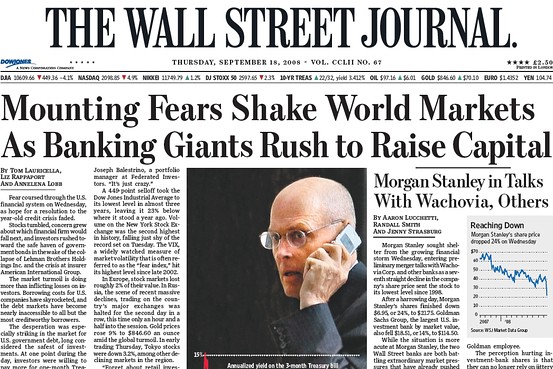
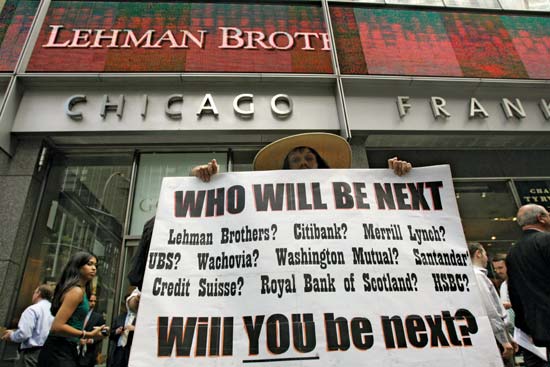
A protest in front of the Lehman
Brothers headquarters in New York
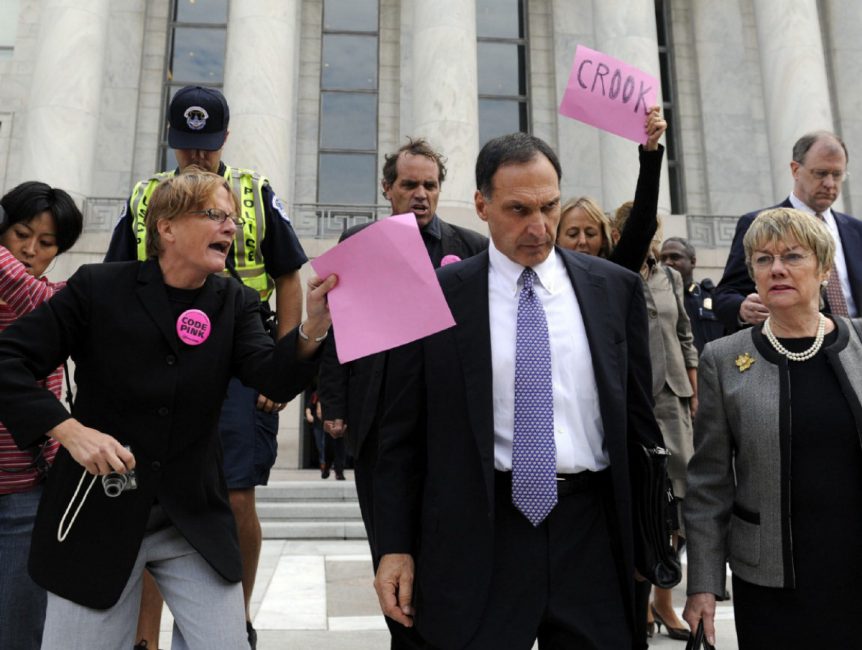
Lehman Brothers CEO
Richard Fuld heckled by protesters upon leaving Capitol Hill – October
2008
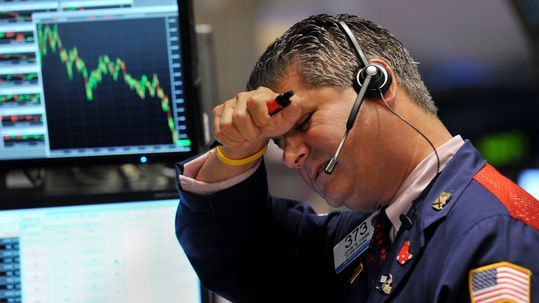
TARP: BUSH MOVES TO BAIL OUT THE TROUBLED FIRMS |
|
Bush's TARP (Troubled Assets Relief Program), October 2008
In late September President Bush introduced a
financial bill into Congress called the Emergency Economic
Stabilization Act of 2008. This bill authorized the U.S. Treasury to
extend to various financially distressed firms (especially the
country's largest banks) available loans totaling $700 billion, termed
the Troubled Assets Relief Program (TARP), to purchase some of the
assets of these companies in order to restore investment confidence in
them. Fears of there being another stock market crash along the lines
of the crash of 1929 if action were not taken immediately were
circulated in an attempt to draw support for this bill from a reluctant
House of Representatives heavily loaded with most Republicans (and many
Democrats) who fervently believed that the government had no right to
get involved with American business.
But despite extensive White House efforts
to line up the necessary support, the bill failed to pass on September
29th when put to a vote: 205 in favor (Democrats 140; Republicans 65),
228 in opposition (Republicans 133; Democrats 95).
However, the scenario of another Great
Depression in the making became more believable when immediately after
the House vote the Dow Jones stock market averages showed a loss of 777
points, the largest single-day loss (up to that point) in the history
of the stock market.2
$1.2 trillion had been lost in stock value in less than three hours!
Two days later the Senate moved on the bill (heavily amended with
"extras" designed to sweeten its provisions), approving the amended
version of the Act, 74 to 25. It then returned in its amended form to
the House where on October 3rd it was finally approved 263 in favor
(Democrats 172; Republicans 91) to 171 opposed (Republicans 108;
Democrats 63). Only hours later Bush signed the bill into law.
This set an interesting precedent – as
some would term it, a "moral hazard" – that somehow it was the
government's job to rescue the capitalist market, in particular firms
that were too big to fail when these companies messed up with bad
investment decisions. True, the TARP very likely would pay for itself
in the long run, presuming that most of these troubled firms recovered
and the government could sell off its holdings in these companies. But
this event provided one more occasion, one more precedent, where the
federal government saw that it had to expand its involvement into new
areas of American life. It had to be the governing backup to the
American economy.
The 2008 bail-out of the American automobile manufacturers
It was not just the American banking
industry that had fallen into trouble in 2008. America's "Big Three"
(Ford, General Motors and Chrysler) auto manufacturers were in trouble,
especially GM and Chrysler. The manufacturers' production capacity was
17 million cars a year; in 2008 the production rate had dropped to only
10 million cars. One of the reasons for the drop was that car purchases
were often financed through second mortgages secured on homes (2
million cars were financed that way in 2007). But with the mortgage
banking crisis in 2008, those types of loans were very hard to obtain.
Also the automobiles of the Big Three were becoming more expensive than
foreign models, because the costs of health care and pensions for an
older work force had to be passed on to the consumer, while at the same
time foreign manufacturers producing their models in the United States
operated with a younger (and largely non-union) work force and thus
cost the foreign manufacturers less in terms of health and pension
costs. This allowed their models to be sold for less than similar Big
Three models. Thus foreign models were taking a larger market share. In
1998 the Big Three accounted for 70 percent of the auto market. By
2008, only ten years later, that figure had dropped to 53 percent.
Another problem was that the Big Three tended to want to manufacture
SUVs and pickup trucks, where the profit margin was much larger (about
15 percent to 20 percent profit on each vehicle), rather than smaller
sedan type car (only about 3 percent profit per vehicle). But the price
of oil had been climbing, and so also gasoline prices at the pump,
reaching $4 per gallon in 2008, causing consumers to back away from the
purchase of the gas-hungry SUVs.
By mid-2008 the panic that had set in
concerning the value of the mortgage banks was also reaching to the Big
Three auto corporations. During the previous several years, GM had been
registering an operating loss which was growing with each year ($10.6
billion loss in 2005; $38.7 billion loss in 2007). By mid-2008 its rate
of sales compared to 2007 were down by 45 percent, and its reserves
that it was drawing from to pay workers' benefits and pensions were
almost completely gone. In mid-November of 2008, representatives of the
Big Three went to Congress to plead for government loans totaling $25
billion to keep their companies from going bankrupt. Republicans were
inclined to let the companies fall into bankruptcy, for this would let
them restructure and get out from under all the expensive workers'
benefits they were forced to accept by the unions. However, Democrats,
fearful of the loss of millions of jobs in the automotive industry,
advocated for an immediate bailout. Meanwhile the shares of the auto
companies dropped away drastically on the stock market.
Finally, after both management and labor
agreed to a reduction in salaries and benefits, an immediate bailout of
$13.4 billion in federal loans and an additional $4 billion early next
year was offered the industry by Congress and Bush out of the TARP fund
(which drew strong criticism as that was supposed to be only for
financial institutions). Along with this went the demand that the
companies had to seriously restructure, before any other TARP funds
would come their way.
2On
March 10, 2020, the Dow Jones Industrial Average fell by 2000 points on
that day alone, caused by the panic that developed over the spread of
the Coronavirus, which was impacting the world, and making its way
towards America.
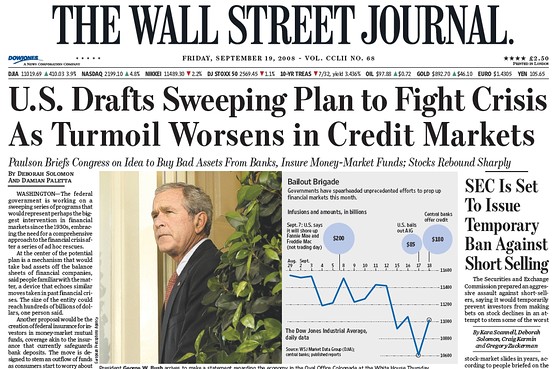
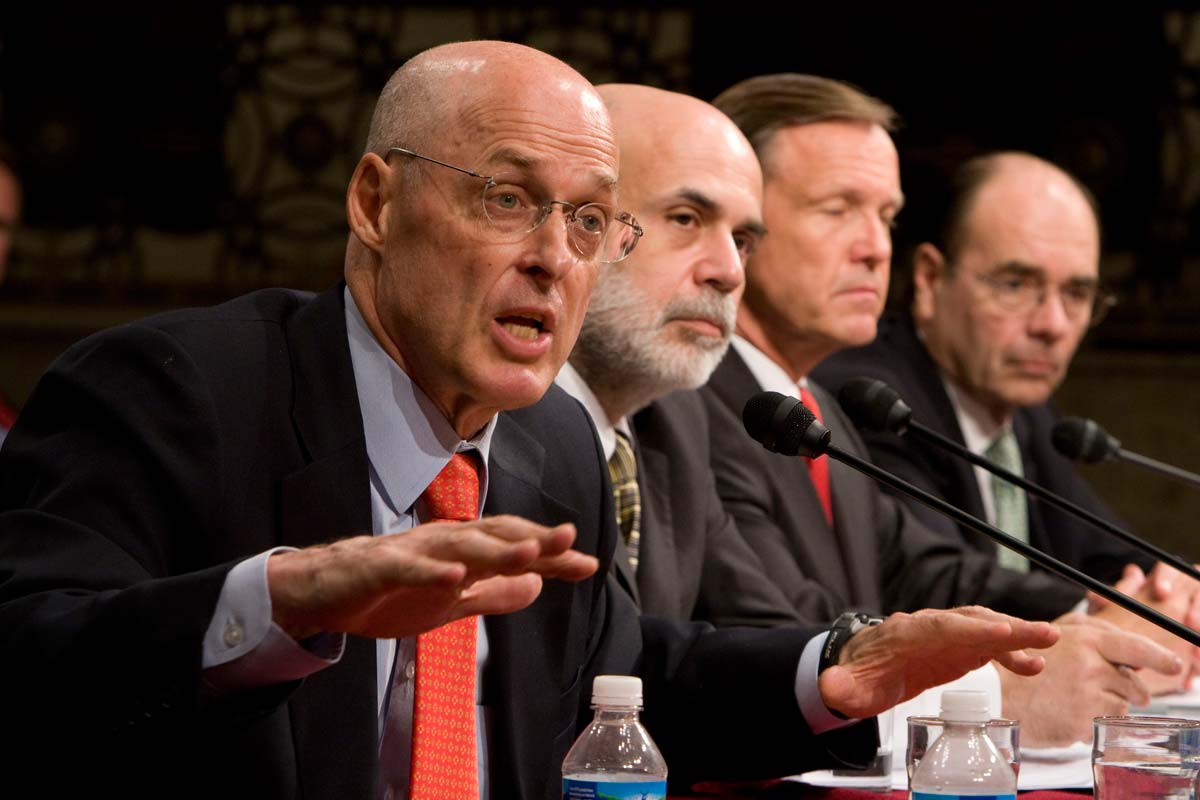
| September 29, 2008 – Treasury
Secretary Hank Paulson (with Federal Reserve chief Bernanke at his side) begs Congress to authorize the
$700 billion corporate bail-out package (the "Paulson Plan"). Congress's first answer
was a "no" ... which immediately plunged the Dow 778
points – the worst single-day loss in the history of the New York's Wall Street stock
market (at that point).
|
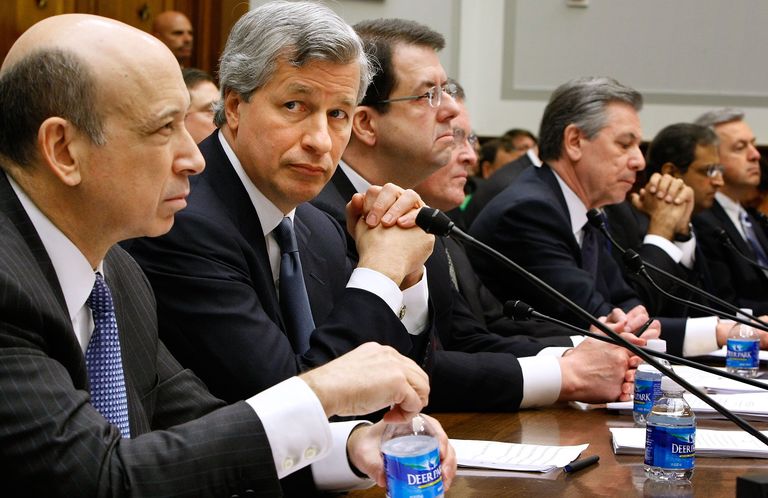
|
Bankers (who were literally forced to take
the government bailout) appearing before Congress – February 2009: CEOs Lloyd Blankfein (Goldman
Sachs), Jamie Dimon (JP Morgan Chase), Robert Kelly (Bank of New York Mellon),
Vikram Pandit (Citigroup), John Stumpf (Wells Fargo). Other banks targeted
for the Government's $125 billion stock purchase of their' preferred stock were State Street,
Bank of America, Merrill Lynch, and Morgan Stanley
|
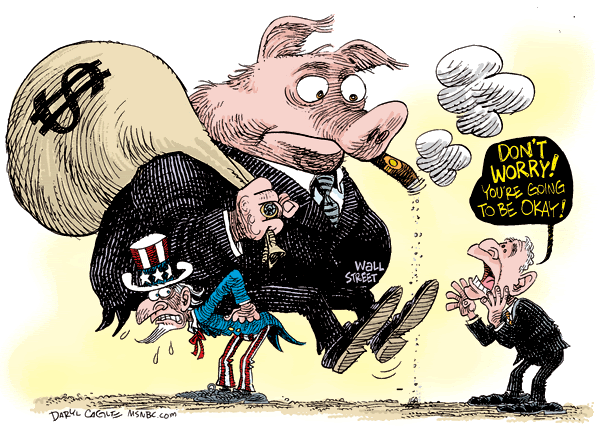
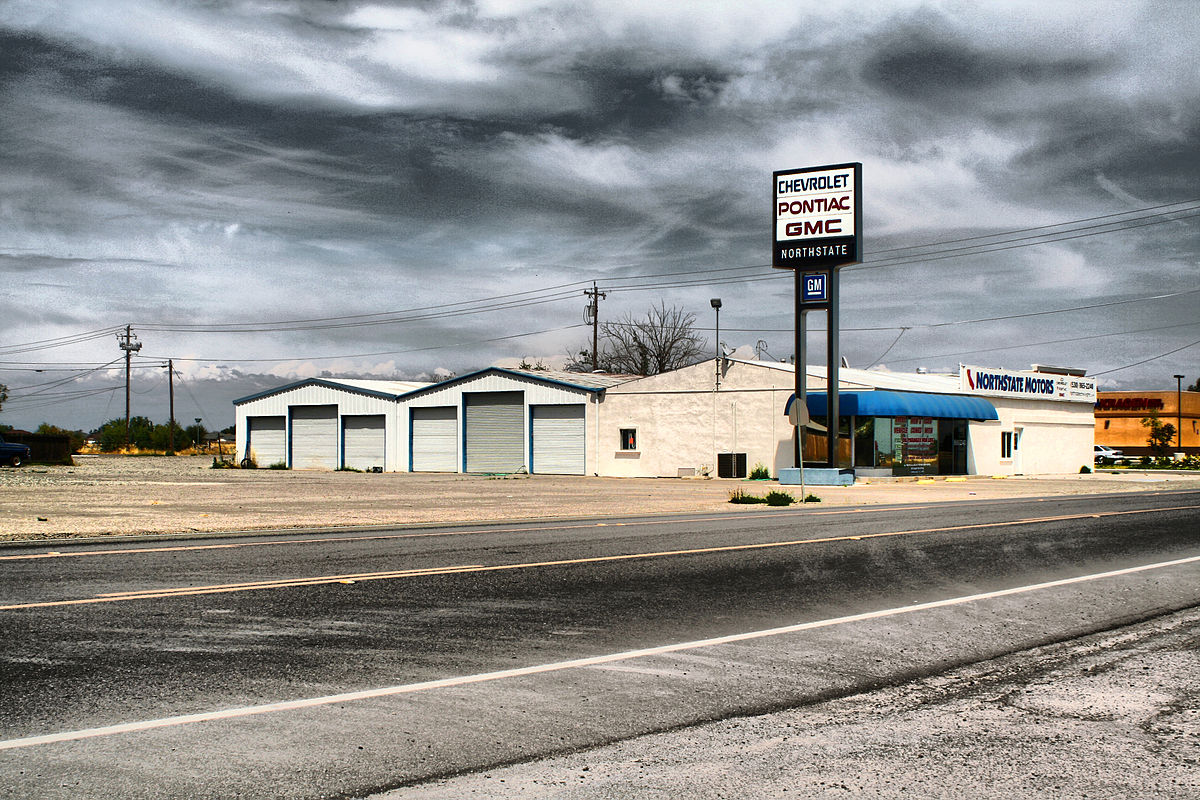 Another car dealer having to go out of
business Another car dealer having to go out of
business

Go on to the next section: On-Going Cultural Conflict
 Miles
H. Hodges Miles
H. Hodges
| | |


 The growing national debt crisis and
The growing national debt crisis and The growing income inequality in
The growing income inequality in The September 2008 financial meltdown
The September 2008 financial meltdown
 TARP: Bush
moves to bail out the
TARP: Bush
moves to bail out the














